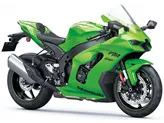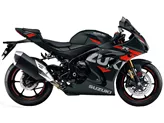Suzuki GSX-R 1000 2017 vs. Yamaha R1 2016

Suzuki GSX-R 1000 2017

Yamaha R1 2016
Overview - Suzuki GSX-R 1000 2017 vs Yamaha R1 2016
The Suzuki GSX-R 1000 2017 and the Yamaha R1 2016 are both high-performance supersport motorcycles that offer impressive specifications and features.
Starting with the engine and drive train, the Suzuki GSX-R 1000 2017 is equipped with a 999cc engine that produces 202 HP of power and 118 Nm of torque. It has a bore of 76 mm and a stroke of 55.1 mm, with a compression ratio of 13.2. The Yamaha R1 2016, on the other hand, has a slightly larger 998cc engine that generates 200 HP of power and 112.4 Nm of torque. It has a bore of 79 mm and a stroke of 50.9 mm, with a compression ratio of 13. Both motorcycles have 4 cylinders and 4 valves per cylinder, with DOHC valve configuration.
In terms of suspension, both motorcycles feature upside-down telescopic forks at the front. The Suzuki GSX-R 1000 2017 has a twin tube, twin-spar aluminum frame, while the Yamaha R1 2016 has a Deltabox aluminum frame. Both motorcycles have double disk brakes at the front.

Suzuki GSX-R 1000 2017
When it comes to advanced rider assistance systems, the Suzuki GSX-R 1000 2017 offers ABS, riding modes, ride by wire, and traction control. The Yamaha R1 2016, on the other hand, offers launch control and traction control.
In terms of dimensions and weights, the Suzuki GSX-R 1000 2017 has a front tire width of 120 mm and a rear tire width of 190 mm, both with a diameter of 17 inches. It has a wheelbase of 1410 mm and a seat height of 825 mm. The kerb weight, with ABS, is 202 kg and it has a fuel tank capacity of 17.5 liters. The Yamaha R1 2016 has the same front and rear tire dimensions as the Suzuki, with a wheelbase of 1405 mm and a seat height of 855 mm. The kerb weight, with ABS, is slightly lighter at 199 kg and it has a fuel tank capacity of 17 liters.

Yamaha R1 2016
In terms of strengths, the Suzuki GSX-R 1000 2017 is known for its high-revving engine, with no dents in the torque curve. It is super stable on corner exit and radius, with a great quickshifter and high-quality chassis. It performs exceptionally well on fast tracks. On the other hand, the Yamaha R1 2016 is praised for its lively handling, high-revving and precisely controllable engine, and excellent electronics package.
However, the Suzuki GSX-R 1000 2017 does have a weakness in that its engine brake is not adjustable. The Yamaha R1 2016, on the other hand, only has a shift assistant for upshifting.
In conclusion, both the Suzuki GSX-R 1000 2017 and the Yamaha R1 2016 are impressive supersport motorcycles with their own unique strengths and weaknesses. The Suzuki offers a high-revving engine and stable performance, while the Yamaha offers lively handling and precise engine control. Ultimately, the choice between the two would depend on the rider's preferences and priorities.
Technical Specifications Suzuki GSX-R 1000 2017 compared to Yamaha R1 2016
Pros and Cons in comparison
Pros and Cons in comparison
Suzuki GSX-R 1000 2017

Suzuki has done a great job with the GSX-R 1000 2017. A super-strong motorbike with a fabulously smooth torque curve. Actually unbelievable at 202 hp! The chassis is of high quality and the electronics package has no tinsel but delivers top performance.
Yamaha R1 2016

Yamaha's high-tech rocket is still a technological leader in 2016. Radical, polarising and fascinating, it sets powerful lap times. It is closer to the race bikes than the other 1000s. In the meantime, no one grumbles about the front. Without the "M", it is the best choice for those who don't need Öhlins anyway, or the best choice for those who are planning a racetrack conversion anyway and like to install "normal" Öhlins hardware without electric stuff.
Price Comparison Avarage Market Price Suzuki GSX-R 1000 vs Yamaha R1
There are a few key differences between a Suzuki GSX-R 1000 2017 and a Yamaha R1 2016. It takes less time to sell a Yamaha R1 with 73 days compared to 121 days for the Suzuki GSX-R 1000. Since model year 2005 1000PS.de editors have written 71 reviews for the Suzuki GSX-R 1000 and 80 reviews for the Yamaha R1 since model year 2005. The first review for the Suzuki GSX-R 1000 was published on 3/3/2004 and now has more than 7,100 views. This compares to more than 3,900 views for the first review on Yamaha R1 published on 4/28/2003.























